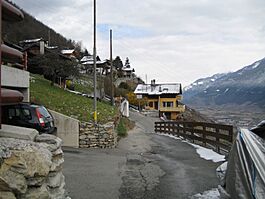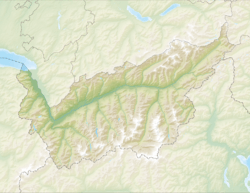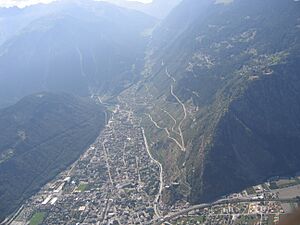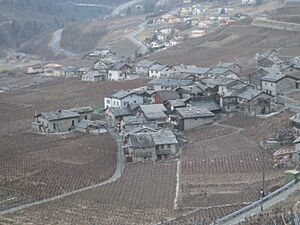Martigny-Combe facts for kids
Quick facts for kids
Martigny-Combe
|
||
|---|---|---|

Sommet-des-Vignes, a section in Martigny-Combe
|
||
|
||
| Country | Switzerland | |
| Canton | Valais | |
| District | Martigny | |
| Area | ||
| • Total | 37.41 km2 (14.44 sq mi) | |
| Elevation | 804 m (2,638 ft) | |
| Population
(Dec 2020 )
|
||
| • Total | 2,333 | |
| • Density | 62.363/km2 (161.52/sq mi) | |
| Postal code |
1921
|
|
| Localities | Martigny-Croix, Le Brocard, Le Borgeaud, Les Rappes, La Fontaine, Le Cergneux, Le Fays, Le Sommet-des-Vignes, Ravoire | |
| Surrounded by | Bovernier, Martigny, Orsières, Salvan, Trient | |
| Twin towns | Pont-l'Abbé-d'Arnoult (France) | |
Martigny-Combe is a small town, also called a municipality, in the Valais region of Switzerland. It is part of the Martigny district. This area is known for its beautiful mountains and valleys.
Contents
History of Martigny-Combe
Martigny-Combe was first mentioned in official records in 1841. Back then, it was simply called La Combe. A few years later, in 1844, it was first known by its full name, Martigny-Combe.
Geography of Martigny-Combe
Martigny-Combe covers an area of about 37.7 square kilometers (14.6 square miles). A large part of this land, about 63.4%, is covered by forests. About 15.5% of the land is used for farming. Only a small part, 3.2%, has buildings or roads. The rest is unproductive land, like rocky areas.
The municipality is located in the Martigny district. Two rivers form its borders: the Trient river to the west and the Dranse to the east. The land rises from the Rhone valley up to 2,700 meters (8,858 feet) high. Martigny-Combe is important because it sits at a crossroads for two major travel routes. One leads to Italy through the Great St. Bernard Pass, and the other goes to France over the Col de la Forclaz.
Villages and Hamlets in Martigny-Combe
Martigny-Combe includes the main village of La Croix. It also has several other villages like Le Brocard, Le Borgeaud, Les Rappes, Le Fays, and Ravoire. Smaller settlements, called hamlets, include Plan-Cerisier, Le Perrey, and La Crettaz.
Coat of Arms of Martigny-Combe
The official symbol of Martigny-Combe is its coat of arms. It shows a silver (white) lion standing on its hind legs. This lion is holding a golden mallet. The background color of the shield is red.
Population and People of Martigny-Combe
Martigny-Combe has a population of about 2,092 people as of 2022. A small part of the population, about 11.4%, are people from other countries. Over the past ten years (2000–2010), the number of people living here grew by about 30.1%. Most of this growth was because people moved into the area.
Languages Spoken in Martigny-Combe
Most people in Martigny-Combe speak French. In 2000, about 93.9% of the population spoke French as their main language. The second most common language is German, spoken by about 2.0% of the people. Italian is the third most common, spoken by about 1.4%.
Age Groups in Martigny-Combe
In 2000, about 23.8% of the population were children and teenagers (under 20 years old). Adults (20 to 64 years old) made up 61.4% of the population. Seniors (over 64 years old) made up 14.8% of the population.
Households in Martigny-Combe
In 2000, there were 753 households in Martigny-Combe. On average, each household had about 2.2 people. About 285 households had only one person living in them. There were 46 households with five or more people.
Important Sites in Martigny-Combe
The entire area of Plan Cerisier is a special place. It is recognized as part of the Inventory of Swiss Heritage Sites. This means it is an important cultural or historical area in Switzerland.
Economy and Jobs in Martigny-Combe
In 2010, the unemployment rate in Martigny-Combe was 4.8%. This means a small number of people who wanted to work could not find jobs.
Types of Jobs in Martigny-Combe
In 2008, there were 289 full-time jobs in Martigny-Combe.
- Primary Sector: About 49 jobs were in the primary sector. This includes jobs like farming and forestry (working with trees and wood).
- Secondary Sector: About 40 jobs were in the secondary sector. This includes manufacturing (making things in factories) and construction (building things).
- Tertiary Sector: The largest number of jobs, 200, were in the tertiary sector. This includes jobs in sales, transportation, hotels and restaurants, information technology, and professional services like scientists and teachers.
Commuting to Work
In 2000, many people living in Martigny-Combe traveled to other towns for work. About 660 people commuted out of the municipality. Only 80 people commuted into Martigny-Combe for work. Most people, about 74.8%, used a private car to get to work. About 10.7% used public transportation.
Religion in Martigny-Combe
Based on the 2000 census, most people in Martigny-Combe are Roman Catholic, about 81.5%. About 7.0% belonged to the Swiss Reformed Church. A small number of people belonged to other Christian churches or Islam. About 7.22% of the population did not belong to any church or were agnostic or atheist.
Education in Martigny-Combe
Many adults in Martigny-Combe have a good education. In 2000, about 37.7% of the population had finished upper secondary education. This is like high school. About 11.8% had gone on to higher education, like university or a specialized college.
Libraries in Martigny-Combe
Martigny-Combe has a library called Bibliothèque communale et scolaire de Martigny-Combe. In 2008, this library had over 8,000 books and other media. It loaned out nearly 10,000 items that year. The library was open for 127 days in 2008, averaging 12 hours per week.
See also
 In Spanish: Martigny-Combe para niños
In Spanish: Martigny-Combe para niños






